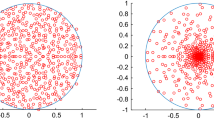Abstract
In this article we deal with the Arov–Grossman functional model to describe all the solutions of the Covariance Extension Problem for q-variate stationary stochastic processes and we find the density that maximizes the Burg Multivariate Entropy. This description is based on a one-to-one correspondence between the set of all solutions of the Covariance Extension Problem and the set of all contractive analytic functions H from the open unit disk with values on the space of q × q matrices. With this correspondence, the density that maximizes the Burg Multivariate Entropy corresponds to the function H\equiv0. Also, from the information that the Arov–Grossman functional model provides we obtain a version of the Levinson algorithm. The partial autocorrelation coefficient matrices are computed directly from Levinson’s recursions.
Similar content being viewed by others
Author information
Authors and Affiliations
Corresponding authors
Additional information
Communicated by Hans G. Feichtinger.
Rights and permissions
About this article
Cite this article
Marcano, J., Morán, M. The Arov–Grossman Model and the Burg Multivariate Entropy. J. Fourier Anal. Appl. 9, 623–647 (2003). https://doi.org/10.1007/s00041-003-0914-z
Received:
Revised:
Issue Date:
DOI: https://doi.org/10.1007/s00041-003-0914-z




